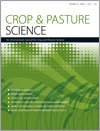Grazed pastures in south-eastern Australia are typically based on temperate (C3) species, such as perennial ryegrass (Lolium perenne). With predictions of warming to occur in this region, there has been growing interest in the performance of more heat-tolerant and deep-rooted subtropical (C4) pasture grasses, such as kikuyu (Pennisetum clandestinum). This study used an existing pasture model to estimate the production of kikuyu compared with the commonly used perennial ryegrass at seven sites in south-eastern Australia, using an historical baseline climate scenario between 1971 and 2010, and the daily temperature of the baseline scenario adjusted by 1, 2, and 3°C to represent potential warming in the future. The seven sites were chosen to represent the range of climatic zones and soil types in the region. First, the model predictions of monthly kikuyu dry matter (DM) production were validated with measured data at Taree, Camden, and Bega, with results showing good agreement. Second, pasture production (t DM/ha), metabolisable energy (ME, MJ/kg DM) content, and ME yield (GJ/ha) were predicted using the baseline and warmer climate scenarios. The study was based on 56 simulations of the factorial arrangement of seven sites × four temperature scenarios × two pastures. The month and annual ME yield of a kikuyu–subterranean clover (Trifolium subterraneum) pasture and a perennial ryegrass–subterranean clover pasture were compared. This study showed that in summer-dominant rainfall locations, where the average maximum temperature is >23°C, kikuyu was a more productive pasture species than perennial ryegrass. In winter-dominant rainfall locations during the warmer months of December–March, kikuyu can provide a useful source of ME when perennial ryegrass is less productive. With warming of up to 3°C at the winter-dominant rainfall sites, the average ME yield per year of kikuyu was predicted to surpass that of perennial ryegrass, but inter-annual variation in kikuyu production was higher. The nutritive value, seasonal distribution of growth, total annual production, and its variability are all important considerations for producers when selecting pasture species.
How to translate text using browser tools
3 May 2013
Effect of warming on the productivity of perennial ryegrass and kikuyu pastures in south-eastern Australia
Matthew J. Bell,
Richard J. Eckard,
Matthew T. Harrison,
James S. Neal,
Brendan R. Cullen
ACCESS THE FULL ARTICLE

Crop and Pasture Science
Vol. 64 • No. 1
May 2013
Vol. 64 • No. 1
May 2013
C3 grass
C4 grass
metabolisable energy
pasture production
SGS model





